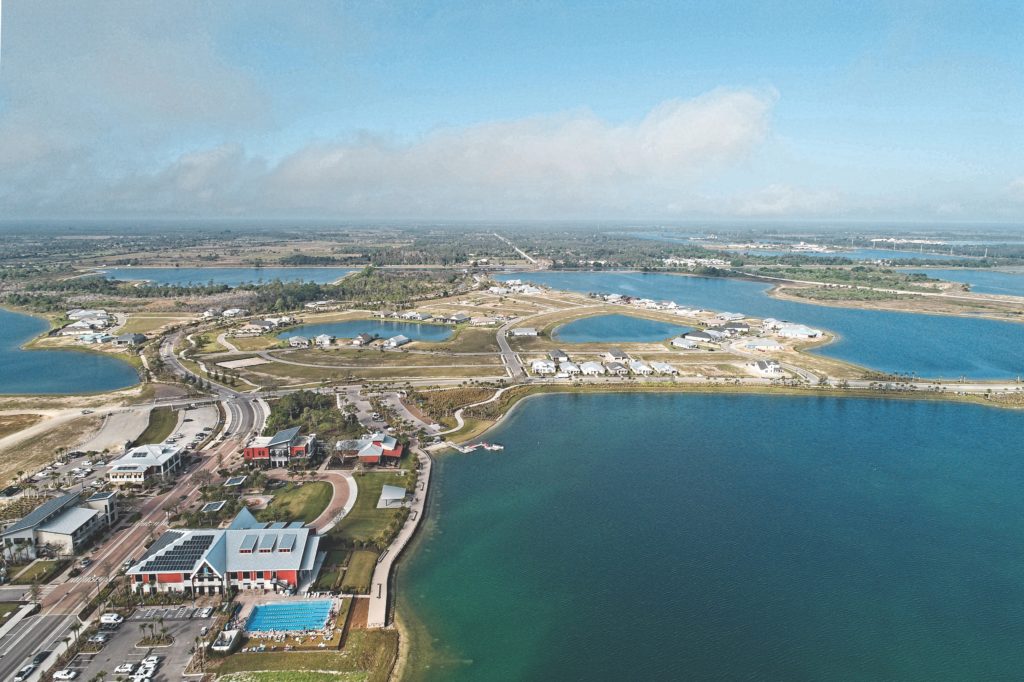She nearly had to pinch herself.
From a second-story window, Donna Aveck looks out onto Founder’s Square, the town’s central hub, where she sees twinkling Christmas lights wrapping palms and draping oaks. Firepits glow. Thousands of people mill about, kids squirmy with anticipation. Santa will be coming.
Donna and her husband, James, who goes by Jim, had been waiting nearly a dozen years for this—for life to be breathed into their new home, Babcock Ranch, the eco-conscious, high-tech, health-minded, solar-powered town emerging out of the wilderness at the Lee/Charlotte county line.
This December 2017 affair is a bit of showmanship (or holiday magic, if you prefer). The development team conjured up a Hallmark-worthy holiday event for an entirely uninhabited town. The first residents, an Atlanta couple, won’t move in for another month. The Avecks, a retired couple living in Punta Gorda, will follow a few weeks later. The turnout, some 4,000 curious merrymakers from surrounding communities, surprises everyone.
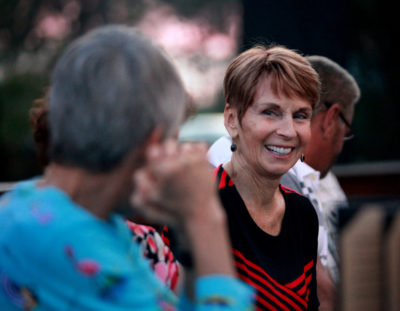
A few of the residents-to-be linger at their VIP reception, but Jim is eager to be in the thick of things. “Follow me!” he urges, bounding down the stairs and snaking his way through the square. He spots empty seats by the pavilion. They are in the front row. How apropos. The Avecks have wanted to be pioneers in this pioneering town ever since they first heard developer Syd Kitson outline his dream back in the mid 2000s.
The couple, starting in summer 2017, offered us a front-row seat, too, to watch their home come to completion and their lives unfold in this experiment-of-a-town that is drawing global attention.
Under the pavilion that bears the town’s cattle brand-inspired logo, children “strum” cardboard guitars and bellow, “Jingle Bell Rock!”
“Oh, I just love this,” Donna says, beaming. “Kids make it feel like Christmas.”
And, she thinks, the presence of children will make the new town feel like home.
We first meet the Avecks about four months earlier at Table & Tap, a farm-to-table-inspired eatery in Founder’s Square. Whatever subsidies Kitson is paying to keep the town’s inaugural businesses afloat show promise of paying off; the charter school opened that month at capacity (with a waitlist) and the restaurant is thriving without so much as a single home being occupied. The Avecks visit weekly.
Pleasantries exchanged, Jim suddenly pushes back from the table.
“Hey, do you want to see it?” he asks. He makes his way to the windows and points: Across a sunbaked field stands the shell of their 1,995-square-foot home. The body of water behind it? That’s Lake James, they say with obvious delight. Pioneering has its perks.

The couple, who are in their early 70s, intend for this to be their last home, and already they love everything about it: the builder (Homes by Towne), the proximity to a community garden, the promised tennis courts and walking trails, and the access to the handsome community Lake House. If Kitson ever wanted a spokesperson, he needed only phone Donna or Jim.
The Avecks had first encountered the developer in 2006 in the wake of a landmark deal among the Babcock family, Kitson and the state to determine the fate of the 91,000-acre property. The ranch, family-owned since the early 1900s, supported vegetable and sod farming, rock quarries and cattle, but mostly it was a vast wilderness. Before Kitson came on the scene, the Babcock heirs had been trying to sell the land to the state. When negotiations failed, observers feared the ranch would go the way of so many other such properties—parceled and sold for development.
Kitson offered to top the government bid and then sell most of the ranch—73,000 acres—right back to the state for conservation. He’d hold on to 18,000 acres for development—but not the kind of high-end subdivisions and golf communities he was known for, such as Naples’ Talis Park. He wanted to create a living laboratory that tested, among other things, his theory that developers could turn a profit and protect the planet. The deal, signed by then-Gov. Jeb Bush in 2006, remains the largest land preservation effort in state history.
Kitson launched into salesman mode. The day the Avecks saw him, he was the guest speaker at TEAM Punta Gorda, a volunteer civic association to which they belonged. Babcock Ranch, he told the group, would focus on seven principles: sustainability, healthy living, education and lifelong learning, technology, transportation innovation, storm safety—and, the clincher, solar energy. Babcock would be the first city in the country, Kitson hoped, to be powered by the sun.
He listed the amenities he envisioned: bike paths, hiking trails and lots of green space; wellness facilities; schools; a wastewater treatment plant for conservation and sustainability; self-driving electric shuttles; gigabit internet in every home. Both residential and commercial developers would have to meet green building standards. He’d encourage attributes like sidewalks and front porches, a throwback to an earlier time when neighbors paused for impromptu conversations.
“We fell in love with his vision,” Donna says. “We’ve always been early adopters of technology, and the idea of the first solar-powered city…”
“Four hundred and thirty acres of solar panels!” her husband interrupts before she strays from the topic.
The Avecks hail from Michigan, where Jim was manager of corporate customer training in the use of telephone systems and Donna was director of technology for two school districts. They raised their son in a tight-knit neighborhood where Jim dressed up as Santa each December.
They have a proclivity for wandering. As newlyweds in 1970, they sold nearly everything they owned and hitchhiked around South America for six months. Jim retired in 1999 and took a job as a flight attendant for the travel perks. When Donna retired four years later, the couple sold everything again and traveled the world for two years.
So when Donna says, “We embrace change,” among her reasons for choosing Babcock, you know she is not kidding.
Not long after that Punta Gorda presentation, Kitson went silent, at least as far as the Avecks could tell. Southwest Florida had sunk into the Great Recession, decimating the construction and real estate industries.
The developer and his crew weren’t idle, however. Babcock Ranch’s plans called for 19,500 homes and a projected 50,000 residents (more than twice the population of the City of Naples). To do so in a way that didn’t wreak havoc on the land would require careful and sophisticated environmental engineering.
The work started along a dirt road a few miles north of town, at the site of Curry Lake Canal, explain Amy Wicks, of the firm Kimley-Horn, and John Broderick, the senior vice president of land development for Kitson & Partners. The canal is a 6-mile trench the Babcocks had dug back in the 1920s to drain the land—a near-universal practice in Florida in their day.
Crews installed a series of weirs along the canal, which allows the water to linger on the land, the way it once did. That extended wet period encouraged new plant and animal life, and it ramped up Mother Nature’s ability to absorb and eat away excess harmful nutrients before the water’s gradual flow south. “It’s one of the things I’m most proud of,” Syd Kitson later says.
Environmental planners took on other projects to lessen the toll of development. They re-engineered the old quarry mines to create lakes for water storage and recreation. They restored existing wetlands and planted new ones. They cleared (and continue to clear) exotic plants. They set limits on turf grass and standards for Florida-friendly medians and common areas—admittedly to mixed reviews, as some residents lamented the landscaping restrictions even as people like the Avecks embraced them.
In all, just 10,000 acres of the town’s 18,000 acres will be developed, and that figure includes rain gardens, bioswales and wetland areas.
Near the Avecks’ neighborhood-to-be, crews have carved out a walking path through a wetland and around “Sunset Lake.” Just before you turn onto their street, you’ll see thickets of newly planted pine trees. Here and there, you’ll come across big old oaks; some 140 of them were saved from earthmovers and replanted.
“You know how a lot of builders will just put a tree every 40 feet, and they’re all in a line?” Broderick asks. “We’re definitely trying to do something a little more natural. We’re trying to reforest little areas. Trees aren’t supposed to be every 40 feet.”
Donna is in the habit of carrying a black Sharpie on the couple’s visits to their under-construction house. They’ve left notes all over the beams. To the construction supervisor: “Ricardo, it was nice meeting you.” To the crew: “This home survived Hurricane Irma 9/10 + 11, 2017. Thank you to the people who are building our home. We hope you and your families are out of harm’s way.” To themselves: “Jim & Donna Aveck, signed contract 2-24-2017.” They’ve scribbled a smiley face next to that one.

Ricardo Buch Van Praet, the aforementioned supervisor, appears at the home site, and the couple greets him like an old friend. Donna bursts out with a request. They want to hide a “time capsule” somewhere in the walls. Ricardo looks at her quizzically.
“I’m thinking upon our death and demise…” she begins by way of explanation.
“Oh jeez,” he responds, rolling his eyes.
“I just think it’ll be interesting if somebody finds it,” Donna says brightly. Next to her, Jim flashes an impish grin.
Ricardo, bemused, agrees to do it. A few days later, the Avecks return with an oversize Mason jar filled with items like The Babcock Telegraph newspaper; keys to their previous homes; a letter explaining who they are and why they chose Babcock; a silly photograph of their faces superimposed on sun-leathered bodies; a flash drive filled with photos of their under-construction home and town—and a note explaining what a flash drive is, just in case the finder comes along many decades from now. Ricardo’s crew will encase it in an angled wall at the corner of the living room.
In just two months, they’ll celebrate that first Babcock Christmas; in just three, they will close on the property.
The man who sold the Avecks on their retirement dream is an affable, one-time NFL guard (Green Bay and Dallas, 1980-84) who went into real estate development once his playing days were done.
“My great passion was hiking and camping and exploring different parts of the country, especially the East Coast,” begins Kitson, who grew up
in a little town in New Jersey, population 12,000. “I have a great respect for nature. Then, you juxtapose that against becoming a developer and you go, ‘OK, how does that work?’”
He grins and continues: “I think what I’ve realized from the beginning is developers have an impact on the environment, and we need to take responsibility for that. We have areas growing quickly throughout the country, and we can’t not build homes for people. If we’re going to do that, let’s do it the right way.”
He had worked on elements of sustainability in previous projects, but Babcock provided him a blank canvas to create something entirely new.
In the course of an hourlong conversation, Kitson stresses everything that Babcock is not, and you get the impression he’s repeated these assertions many times over. It’s not Disney World. (“With Disney, if you look behind the curtain, there’s nothing there. It’s just a façade.”) It’s not a gated, master-planned community. (“It’s a real hometown. There’s a real downtown … a sense of community, a real place.”) And it’s not “out there.” (“Whenever I have meetings with people, they’re usually here a half-hour early. They walk in the door and go, ‘I didn’t realize it was so close.’”)
Kitson fights the notion that green standards increase the cost of living. Florida Power & Light charges the same rate for solar-generated energy as it does for its traditional grid. Meeting green building standards adds relative “pennies” to the cost of construction, Kitson says, and adding swales and rain gardens costs less than laying pipes to keep excess water out of people’s yards.
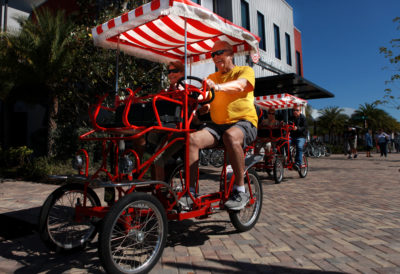
The data on energy savings are encouraging. The 75-megawatt solar field is projected to save more than a million British Thermal Units worth of natural gas and avoid nearly 72,000 tons of carbon dioxide per year, equivalent to taking 12,000 cars off the road. The average Babcock house is performing 26 percent better than the minimum Florida Energy Code. Outcomes on other Babcock goals may be harder to quantify. Kitson wants to know: Does living in a community designed for walkability and recreation inspire healthy habits? In addition to the town’s infrastructure, Lee Health opened a massive wellness center (the Avecks signed up on opening day), and a community lifestyle director, Michelle Churchill, is constantly scheming up activities from sports leagues to road races to holiday events.
“There has been this movement for people sitting inside, in front of a screen, especially for kids. If you live in a healthy community and in a healthy environment, you’re gonna live longer, you’re gonna be healthier and you’re gonna be happier,” Kitson says. “Now, this is not a utopia and we’re not trying to create a utopia, but what we’re trying to do is create a place where we truly get people outdoors and we celebrate the outdoors.”
There’s a subset of people, the Avecks among them, who came to Babcock because it supports their already active lifestyles. The test is whether they’ll inspire the couch-inclined to get outdoors.
“I think that’s part of the legacy of what I hope to get done here,” Kitson says.
At the breakfast bar of his new house, Jim can’t help but jingle the couple’s new keys. They echo in the empty space, a little like sleigh bells leftover from Christmas a few weeks before. It’s early January 2018, and the Avecks have just finished signing their closing documents.
“We’ve been waiting,” Donna pauses and does a quick calculation, “for 12 years to live at Babcock Ranch.”
Two weeks later, the moving van rumbles to a stop on Bridle Trail. Donna and Jim follow. They pause in the driveway. Donna reaches over and hugs her husband. “We’re home,” she tells him. “This feels like where we’re supposed to be.”
There’s a lingering odor of new paint. The tile floors, freshly sealed, gleam. Donna stands in the middle of the great room, directing traffic. Jim stays out of the way. About 90 minutes into the move, Robin and Richard Kinley, the Atlanta couple who beat the Avecks by a few weeks, appear in the foyer, gift basket in hand.
“Oh, it’s so nice to have neighbors!” Robin exclaims. The couples joke that the entire population of Babcock Ranch is standing in that living room. They swap phone numbers.
The movers carry in a long, flat box labeled “Fragile.” Donna opens it carefully. Inside is a delicate white Christening gown preserved in a gilded frame. Jim’s. She holds the heirloom against an alcove wall.
It fits perfectly. This really must be home.
On a blustery morning about a month and a half later, Jim and Donna drive a few miles north, to Babcock’s solar field where Syd Kitson and representatives from Florida Power & Light are unveiling something big: the nation’s largest solar storage system, an answer to a conundrum that has challenged the growth of solar energy—how do you keep the lights on after the sun goes down? This new system feeds unspent daytime energy to battery units that continue powering the town. Once those are exhausted, the town automatically switches to the traditional grid.
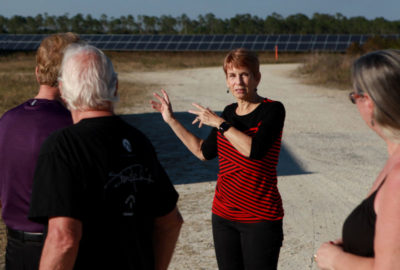
The Avecks and the similarly curious Kinleys follow a throng of reporters, FPL officials, Kitson & Partners representatives and other dignitaries up a wooden ramp to a three-story-high observation tower. From up here, the 343,000 solar panels, denim blue in color, stretch endlessly, like a sea.
“Solar is a terrific technology except it is an intermittent resource,” explains Matt Valle, the FPL vice president for development. “Battery storage is really where the industry is going.”
Like other attributes of Babcock, this technology will be monitored and used to guide the development of other projects.
There’s a lot of misinformation about Babcock’s solar power, Kitson explains at a later time. Many consumers think “solar town” means every homeowner has to install pricey solar panels. They don’t. But a number of them do, allowing them to generate their own power. Thanks to the influence of another family, the Avecks will eventually purchase them, too.
If the Avecks’ little house on Bridle Trail appears lonely at first, its occupants are anything but.
Donna had promised the couple would be the “welcome wagon” as the moving vans pulled in—and they are.
By the summer, she is the town’s unofficial record-keeper, inviting newcomers to add their contact information to neighborhood directories. She helps Churchill, the lifestyles director, update online community calendars. She and Jim organize weekly get-to-know you dinners at Table & Tap, affairs that draw, on average, 16 to 18 people and once host a record 26.
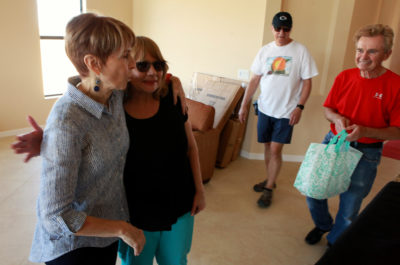
The Avecks pair up with other couples for card games. Donna starts regular morning walks with an athletic woman named Beth, a retired psychologist who bought a house on the other side of Lake James. Their soon-to-be closest neighbors, Oregonians Jan and Ed Hanney, who are renting an apartment in Fort Myers, come by regularly to check on their home’s progress and enjoy the Table & Tap gatherings. Come Halloween, Jim dons a costume and scares little kids at the town’s first Trunk or Treat. They reciprocate by tip-toeing up to him, poking his rear and dashing away.
Visits to Babcock feel like a prolonged freshman year—a clutch of strangers thrust together and expected to form a community, stat.
And like a college dorm, news can spread like wildfire.
One November day, Donna helps disseminate this happy headline: Babcock Ranch’s first baby had been born—a little girl delivered at home to a young couple (the same one who had purchased solar panels and inspired the Avecks to do the same).
Josh and Jasmin Day live in the Trails Edge neighborhood east of Founder’s Square. When we meet, Eden is 4 months old. Her tow-headed, rambunctious brothers, Judson and Elliot, are 3 and 2, respectively. Jasmin offers the boys a few minutes of screen time, but they prefer to scamper around the living room.
The Days, of Tennessee, had been introduced to Babcock by a coworker of Josh who had seen a national news story about the place and joked that the new town would be perfect for the “crunchy” couple with the fastidiously clean diet and cloth diapers and love of the outdoors (not to mention they were considering a move to Florida, anyway). They looked it up, and within the week, they put a deposit on their Babcock Ranch house. Josh, a newly licensed physical therapist, called Lee Health to inquire about job opportunities. The health system had planned to post an opening at its new Babcock Ranch wellness center the very next day. Talk about fate. Josh got the job.
Like the Avecks, the Days positioned themselves at the hub of activity. Jasmin started a Facebook page for Babcock families and organized ladies’-night-out events. Josh intended to start social activities for the guys.
“They literally have become our family,” Jasmin says of her neighbors.
They’d been in the house for only a few months when neighbors threw a baby shower. A friend up the street took care of the boys during Jasmin’s labor. After Eden’s birth, neighbors hired a housekeeper to give the young mom a break. The chef at Slater’s, a Babcock market and café, cooked up a giant tray of vegetarian, gluten-free lasagna.
“It was huge—it lasted for like four days,” Josh remembers. “Even the restaurant staff is kind of like family.”
They believe a common set of principles helps solidify these neighborly bonds.
“Not everyone is going to cloth-diaper,” Jasmin says. “Not everyone is gonna have solar panels on their house…”
“… or eat as clean as we do,” Josh interjects.
“… but as a collection,” Jasmin continues, “we are all very mindful in our choices. I think that’s the thing that has drawn in a lot of people, the connecting thread.”
Sometimes watching her town come together feels like watching paint dry, Donna admits one November morning. But she thinks back to that Christmas party a year ago, when their home was still incomplete and not a single resident lived in town, and she realizes how swift the progress has been.

More than 200 homes had sold. The charter school had moved from its temporary quarters into a permanent building. A much-needed preschool prepared to take over the vacated space. Lee Health had introduced physician offices. The first community park was about to open, and along with it the opportunity to start pickleball and tennis leagues.
The couple offers a driving tour. They point out the homes of all the people they’ve gotten to know: the Kinleys, the Arnolds, the Smiths, the Bishops, the Severances (parents of Rick, the president of Babcock Ranch).
The occupied homes are scattered amid houses under construction, houses up for sale, houses barely yet started.
Even when all of these houses are done, they will represent a mere fraction of what’s coming. It’s almost impossible to imagine this prairie-like landscape at build-out—whether you are mere observer or a member of a team creating the place.
“I didn’t understand the magnitude of Babcock,” Tyler Kitson—Syd’s son—admits one afternoon. He’d been in high school when his dad started chasing the land deal. “Most people don’t understand the magnitude.” The town, he likes to tell visitors, will be 2 square miles larger than Manhattan and will house some 50,000 residents—so many that Publix intends to build five grocery stores to serve it.
The younger Kitson, who joined his dad’s company about four years ago, is sitting in the Hatchery, a co-working space on top of Slater’s. Gesturing to his left, he indicates the next hub of commercial activity—the development of “B Street,” which will run perpendicular to Lake Babcock Drive, the main thoroughfare. Kitson & Partners had just lured Lucienne Pears from the Charlotte County Economic Development Office, which she directed, to serve in a similar capacity for the new town. It was quite the coup.
Tyler Kitson ticks off a list of what’s to come: a recreation center that will double as a storm shelter; an insurance company; a hydroponics company; a new, high-end golf course community; and town homes and condos to diversify the housing stock. Designs for B Street were underway and with them, lots of conversations about the kinds of businesses and services residents wanted to see.
Kitson & Partners, he says, is chasing companies large and small. Babcock cannot become its intended work-live-play community as long as residents have to commute to well-paying jobs. The elder Kitson later discloses he’s negotiating with five big firms to come to Babcock but keeps the names under wraps. “They’ll be big announcements,” Syd Kitson promises. “Every one of them is big.”
Any business within town boundaries has to meet Babcock’s green building code requirements. But development begets development, and you have to wonder what might happen to this slice of rural Southwest Florida in the areas outside of Syd Kitson’s control.
The founder agrees the concern is a legitimate one. “But here’s the good news: All the land surrounding us is in preservation forever,” he says, noting the land deal in which he sold back most of the ranch for preservation. As for the acreage lining State Road 31 that’s not state-owned, Kitson hopes county officials will consider environmental impacts when permit applications come before them.
“Florida depends on its natural resources for its economy,” he says. “We really need to be thoughtful about how we think about water quality. I think water is just such a big issue. As this state grows, it just has to grow right.”
It’ll be decades before we know whether Kitson found a way to “grow right” and balance the needs of people and those of the planet. Fifty thousand people is an enormous infusion to any community, but the impact is magnified when in an area as sparsely populated as the State Road 31 corridor, pre-Babcock.
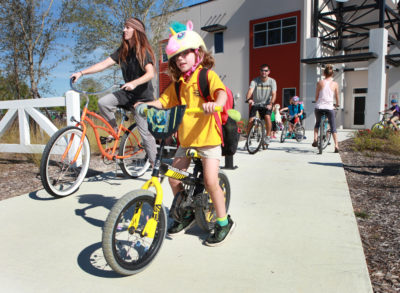
Nevertheless, Kitson’s sustainability practices are promising enough that other developers are seeking his guidance. “They want the playbook,” Kitson says. He can’t yet divulge those locations. One, he says, is in Florida.
On Bridle Trail, the Avecks’ giddy excitement over their new house has tempered, as you might expect, but their fondness for it and their certainty over their pioneering retirement choice is as fresh as ever.
Jim’s birthday rolls around in early February, a year and two weeks after their Babcock anniversary. He chooses to spend it at Table & Tap restaurant with his neighbors. The night is clear and 10 of them gather by a big oak tree strung with lights. Jan and Ed Hanney, the Oregonians, have just moved into their house, a lot away from Donna and Jim and close enough to hear Jim “grousing” from his lanai, Ed teases. The neighbors pass around a phone with photos of the sand hill cranes that have taken to roaming the streets. They pass on a rumor about Babcock Ranch getting its own zip code and express hope that it’s true. They swap tales of earlier escapades because as fast as these friendships have formed, there are decades’ worth of history to divulge.
Jim looks up.
“Hey, what star is that?” he asks.
In the night sky, a bright light shines over the new town, perhaps a celestial tribute to this pioneering band. There’s no doubt Babcock Ranch will be in the spotlight for many years to come.
Photography by Stephen Hayford.

